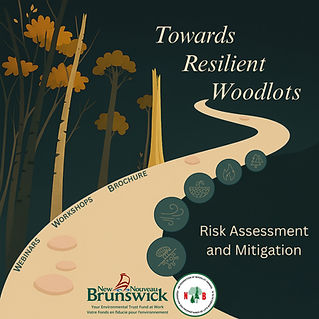Your Forest in a Changing Climate
< return to Resource Center

A healthy and resilient forest is a productive forest.
Whether your goals for your woodlot include timber volume, carbon sequestration, biodiversity, recreation, or all of the above - managing your woodlot for the future means making decisions today that take our changing climate into consideration.
Since 2018, NBFWO has been working to build the capacity of small private woodlot owners to adapt to changing environmental conditions.
Our goal has been to educate woodlot owners so they are better able to make management decisions for their woodlots that not only meet their own goals for their woodlot but also take into consideration the impacts of a changing climate, potential carbon sequestration, and implementation of best management practices, resulting in forests that are more climate resilient.
Our work has been supported by Natural Resources Canada, GNB's Environmental Trust Fund and the work of many parnter organizations.
2018 to today and into the future
2018 to 2022
Between 2018-2022, the NBFWO led a project to build the capacity of small private woodlot owners to adapt to changing environmental conditions (Building the Capacity of New Brunswick Woodlot Owners to Adapt to Climate Change). This project was supported by Natural Resources Canada’s Building Regional Adaptation Capacity and Expertise (BRACE) Program, GNB’s Environmental Trust Fund, as well as through work by our project partners, Community Forests International, University of New Brunswick and the NB Department of Natural Resources and Energy Development.
How did we do it?
-
We created a climate adaptive silviculture prescription tool, with guidleines that incorporate climate change adaptation and carbon sequestration (aka "the Tool").
-
We held workshops and webinars with woodlot owners and forestry professionals to raise awareness about climate change impacts on forests in New Brunswick.
-
We created a training video series.
-
We held a 2-day online conference in 2022 highlighting the work of the project and some of the research work being done by other groups and UNB masters students.
-
We created a Case Study to compare how forests are impacted by different silvicuture treatments. We established study sites on 4 woodlots throughout the province, each containing a Control plot, a Climate Adaptive treatment plot, and a plot that was treated with 'Traditional' methods. These sites will continue for many years as we watch, record and learn from them.

Use the tabs above to learn more - explore the Case Study, watch the video series and recordings from the webinars and conference, download "the Tool".
In 2024, we started a new out-reach program on 'Climate-Smart Woodlot Management', funded by the Environmental Trust Fund (ETF).
The project goal was to raise awareness among woodlot owners about the climate challenges the Wabanaki-Acadian forest is facing, and to provide them with the resources needed to support them in implementing climate-smart management on their woodlot(s).
The NBFWO would like to thank the ETF for its support, as well as its collaborators, without whom this project would not have been possible.
The project began in August 2024 and ran through March 2025. We carried out several activities aimed at achieving our goal. These efforts were essential in enhancing the Wabanaki-Acadian forest's ability to face climate change, while empowering woodlot owners with the tools to adopt climate-smart management practices.
How did we do it?
-
We conducted a literature review to gather the most up-to-date information on the subject.
-
We collected new data at the demonstration sites that were established in 2021.
-
We hosted a series of one-day workshops to raise awareness and educate woodlot owners.
-
We developed a guide to provide woodlot owners with valuable information on climate-smart management.
-
We wrote and published articles in the Federation's monthly newsletter to provide project updates and share new information on the subject.
-
We hosted a webinar to further engage and educate woodlot owners (video tab).
These activities were carried out in collaboration with the demonstration sites’ landowners as well as foresters. Their expertise and experiences were incorporated throughout the project.
Use the tabs above to further explore these initiatives, download "the Guide", and access “the Tool”.
2024 - 2025

2025 - 2026
For 2025-26, we have received funding from the GNB Environmental Trust Fund to continue to expand our education activities, focusing on Risk Assessment and Mitigation for woodlots.
We will be hosting a series of webinars and workshops in the Fall of 2025. Keep and eye on the Calendar of Events and the monthly Member Newsletter for more information to come!

What can you do?
#1 Know your woodlot
Whether you have owned your woodlot for many years, or are new to managing a woodlot, the most important factor in adapting your woodlot to be more resilient to climate change is knowing what is there. Once you establish what you have, you can work towards what you want it to become.
We recommend contacting your local Forest Products Marketing Board and having an evaluation done. A forestry professional can help you create a silviculture management plan you can refer to for years to come.
#2 Get informed and stay informed
We don’t have all of the answers, but the NBFWO is partnered with many local, provincial, and federal groups that have the latest data and information that you need to make smart decisions about your woodlot. We keep listings of useful web pages that can provide you with the information you need, or can help you find what you are looking for.
#3 Don’t wait, start now!
“The best time to plant a tree is 20 years ago. The second-best time is now.” - proverb

photo by Nicole Violette Laforge
Supported by Natural Resources Canada’s Building Regional Adaptation Capacity and Expertise (BRACE) Program

















